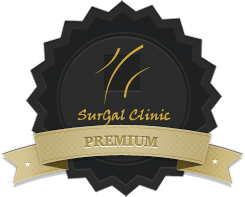Arthroscopy - shoulder joint
Introduction
After the knee, the shoulder joint is the human joint which is the second-most common focus of arthroscopy. There was gradual progress in arthroscopic operations on the shoulder in the 1980s. Initially, only diagnostic procedures were carried out. Later, with growing experience, the range of procedures expanded. New technological procedures also contributed to this development. New instruments and a broader assortment of surgical tools were introduced which had been developed especially for arthroscopic work on the shoulder.
Anesthesia
We employ general anesthesia for arthroscopy on the shoulder joint, sometimes in combination with regional anesthesia. General anesthesia is gentle on the patient and allows for good muscle relaxation. It also allows for hypotension to be controlled to reduce postoperative bleeding (the difference between systolic blood pressure and pressure in the joint should be less than 49 mmHg). Regional anesthesia is most often used to relieve postoperative pain, which is partially due to the solution which is instilled in the tissues around the joint. It involves a blockade of the posterior portion of the brachial plexus, primarily using an interscalene block. A supraclavicular block may also be used. The blockade lasts for 24-48 hours after surgery, substantially cutting back on the need for opiates.
Position and Access Points
Two basic patient positions are used for arthroscopy of the shoulder joint.
- Side Position: The patient lies on the side which is not to be operated on. The limb which is the subject of the operation is stretched using a pulley with both horizontal weighting (ca 4-6 kg) and vertical weighting (ca 2-5 kg). This stretching motion is used to stabilize the shoulder joint. The stretching achieves light distraction of the joint, thereby allowing better manoeuvrability with the surgical instruments and arthroscope. The patient lies with the torso inclined dorsally to an angle of 20°, which allows us to bring the glenoid to the horizontal position. The patient is normally secured in this position using two stops placed in the back area and one in the front. The lower leg must be supported in the region of the bone prominence.
- Beach Chair Position: The patient is placed in a semi-sitting position with the upper body elevated 40°-60° and the shoulder to be operated on placed slightly over the edge of the operating table. This position is preferred by some surgeons for operations around the subacromial space to repair a damaged rotator cuff.
Surgical Access Points
A number of access points for operating on the shoulder joint are described in the literature. We present only a few of these as an overview. The basic division is on access points to the glenohumeral joint (A) and the subacromial space (lateral access points, B).
A. Glenohumeral Access Points
- Posterior:
- classic posterior access point, soft spot, Andrews: This point is located 1.5 cm medially and 2 cm distal from the posterolateral border of the acromion. A palpable soft indentation – a soft spot – is found at this location. It is the interval between m. teres minor and m. infraspinatus.
- central posterior access point, Wolf: This point is located 1-2 cm medially and 2-3 cm distal from the posterolateral border of the acromion.
With either access point, the trocar is introduced in the direction of the proc. coracoideus after an incision is made in the skin. In using these access points, care must be taken not to injure n. axillaris, a. circumflexa posterior or a. suprascapularis. - Anterior:
- central anterior access point, Mathews: This point is located in the so-called safe triangle zone, consisting of the long tendon at the head of the biceps, the glenoid boundary and the m. subscapularis. tendon.
- lower anterior access point, Wolf: This point is located at the lower boundary of the upper glenohumeral ligament.
- lower anterior access point, Wolf: This point is located between the proc. coracoideus a acromion and provides a clear overview of the front portion of the shoulder joint.
- "5 o'clock" access point, Davidson and Tibone: This point is located at the five o'clock position on the edge of the glenoid over the capsulolabral complex, near the edge of the lower glenohumeral ligament.
These anterior access points are partially used for the inside-out technique, in which optics are introduced into the required intraarticular opening. They are then replaced with the trocar, which is used to penetrate the soft tissue, or we orient ourselves by palpation or translumination. The second most frequently used technique is outside-in, which appears safer in terms of soft tissue damage. - Upper:
- supraclavicular, Neviaser: This point is located between the clavicle, medial boundary of the acromion and the spine of the scapula. The trocar is introduced somewhat to the dorsal side via m. supraspinatus.
B. Subacromial Access points (Lateral)
- Posterior:
- posterolateral access point, Elmann: This essentially corresponds to a cutaneous incision at the location of the glenohumeral access point. It is located 1.5 cm medially and 2 cm distally from the posterolateral edge of the acromion, but the trocar goes under the acromion. - Anterior:
- anterolateral access point, Elmann: This point is located 2 cm laterally from the edge of the acromion on a line extending from the anterior boundary of the acromion. - Lateral:
- lateral subacromial approach: This point is positioned slightly distal beneath the edge of the acromion, 2 cm dorsally from its anterolateral boundary. - Upper:
- superolateral access point, Laurencin: This point is located laterally from the acromion on the line connecting the acromion to the proc. coracoideus.
Indications
- impingement syndrome (subacromial decompression)
- rotator cuff ruptures
- shoulder dislocation
- SLAP lesions
- lesions of the tendons at the long head of the bicep
- other (synovitis, cartilage lesions, free bodies)

